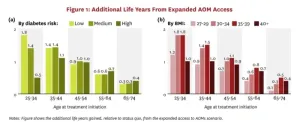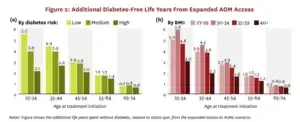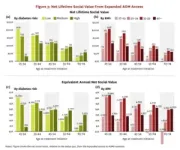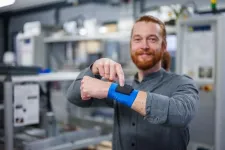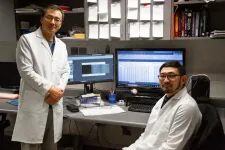(Press-News.org) A new USC Schaeffer Center white paper finds expanded access to anti-obesity medications would lead to significant increases in life expectancy and disease-free years while generating a substantial societal return on investment, even after accounting for treatment costs.
More than 4 in 10 U.S. adults have obesity, which is linked to increased risk of over 200 diseases — including heart disease, diabetes, cancer and dementia — and costs society $260 billion annually to treat. Highly effective new anti-obesity medications can be a powerful tool against chronic disease, but fewer than one-third of health insurers cover them amid concerns about upfront costs.
Expanding access to anti-obesity medications for all adults without diabetes who qualify would generate $10 trillion in social value by enabling people to live longer and healthier lives, Schaeffer Center researchers found. Further, the investment in expanded access would yield returns to society exceeding 13% annually, which is comparable to returns on early childhood education for disadvantaged children and nearly double the U.S. stock market’s returns this century — investments widely regarded as valuable.
“While the costs of anti-obesity medications have grabbed headlines, our analysis shows why it’s important to consider the lifetime value of treatment. Expanding access will prevent or delay obesity-related comorbidities, resulting in improved quality and quantity of life for many Americans,” said Alison Sexton Ward, a research scientist at the Schaeffer Center and co-author of the study.
The analysis comes as federal officials consider a proposal to expand Medicare and Medicaid coverage of anti-obesity medications — a move that, if adopted, could also encourage broader coverage among private insurers. The new study builds on a widely cited 2023 Schaeffer Center white paper that found Medicare coverage of these medications could result in as much as $175 billion in cost offsets to the program over the next decade by reducing demand for care.
Expanded access generates value for more than just the sickest patients
Schaeffer Center researchers leveraged an economic-demographic microsimulation model known as the Future Adult Model to project the lifetime trajectories of health, medical spending, treatment costs and other economic outcomes for adults 25 and older without diabetes who qualify for anti-obesity medication under clinical guidelines. These findings were broken down by age group, body mass index (BMI) and risk of developing diabetes.
Although branded competition typically pushes down net prices of high-cost drugs even before cheaper generics arrive, the researchers conservatively assumed the net price of anti-obesity medication would remain constant before declining substantially when expected generic competition begins in 2032. The net price, which includes rebates and negotiated discounts, is estimated at about 55-65% below the list price and is consistent with net price estimates used by the Congressional Budget Office.
Younger and healthier adults who qualify for the medications were found to benefit the most from expanded access, though all age groups would have longer lives and less time with diabetes. As many as 1.8 years would be added to the lives of adults starting treatment at ages 25 to 34, while they would have as much as 5.9 additional years without diabetes.
Researchers determined the social value of expanding access by weighing the value of longer, healthier lives and savings from reduced medical costs against treatment costs.
Because of the years gained in better health, the greatest social value comes from treating younger and heathier adults. For instance, treating a 25-year-old with low immediate risk of developing diabetes on average generates nearly 30% higher lifetime social value than treating a 35-year-old with similar risk.
“Insurers often limit coverage of anti-obesity medications to sicker patients, such as those with prediabetes or diabetes, but our analysis shows they are likely missing out on a chance to prevent worse and more costly outcomes through early treatment,” said co-author Darius Lakdawalla, chief scientific officer at the Schaeffer Center and professor at the USC Mann School of Pharmacy and Pharmaceutical Sciences and the USC Price School of Public Policy.
It's not just younger and healthier people. The lifetime net social value is positive for nearly every group the researchers analyzed.
Strong investment returns found across populations
Researchers also estimated the annual return to society for each dollar invested in expanding access to anti-obesity medication, reflecting the long-term health and economic benefits of such treatments.
Expanding access would broadly generate compelling rates of return across different groups of patients. This measurement, known as the internal rate of return (IRR), exceeded 13% for all subgroups with obesity (BMI of 30 or higher) over a 30-year period.
“Expanding access to anti-obesity medication is probably the single most effective policy to improve Americans’ public health,” said co-author Dana Goldman, co-director of the Schaeffer Center and founding director of the USC Schaeffer Institute for Public Policy & Government Service. “The challenge will be to do it in a way that rewards innovators but keeps the public costs low."
END
Expanding access to anti-obesity medications delivers 13% return on investment for society
Schaeffer Center white paper finds broader use of treatments may prevent or delay chronic disease by years, providing significant societal benefits
2025-03-27
ELSE PRESS RELEASES FROM THIS DATE:
Genetic defense breakthrough: plants repurpose stomatal genes to fend off herbivores
2025-03-27
Ikoma, Japan—Throughout evolution, plants have continuously adapted to survive in changing environments. Apart from complex structural changes, plants have also developed various defense strategies against herbivores, including tougher protective layers, thorns, and chemical deterrents. Delving deeper into the evolution of defense mechanisms, a research team led by Assistant Professor Makoto Shirakawa from Nara Institute of Science and Technology (NAIST), identified a surprising genetic adaptation in the Brassicales plant order. In these cruciferous ...
David B. Allison, Ph.D., Daniel W. Belsky, Ph.D., and Arlan Richardson, Ph.D., to receive 2025 Scientific Awards of Distinction from the American Federation for Aging Research
2025-03-27
New York, NY — The American Federation for Aging Research (AFAR), is pleased to announce the 2025 recipients of three of its annual Scientific Awards of Distinction: David B. Allison, PhD, will receive the Irving S. Wright Award of Distinction; Daniel W. Belsky, PhD, will receive the Vincent Cristofalo Rising Star Award in Aging Research; and Arlan Richardson, PhD, will receive the George M. Martin Lifetime Achievement in Mentoring Award.
The Irving S. Wright Award of Distinction is named in honor of AFAR’s founder and recognizes exceptional contributions to basic ...
Pregnant women advised to avoid mentholated e-cigarettes
2025-03-27
RIVERSIDE, Calif. -- Vaping during pregnancy is becoming more common, but its impact on early human development is not well understood. A new study by scientists at the University of California, Riverside, now reports that the flavor chemical menthol used in electronic cigarettes could pose risks to a developing baby.
The study, published in STEM CELLS Translational Medicine, used human embryonic stem cells, or hESCs, to characterize early stages of embryonic development and examined how low concentrations of menthol affect important cellular processes.
The ...
Smart textiles and surfaces – How lightweight elastomer films are bringing tech to life
2025-03-27
Clothes that can mimic the feeling of being touched, touch displays that provide haptic feedback to users, or even ultralight loudspeakers. These are just some of the devices made possible using thin silicone films that can be precisely controlled so that they vibrate, flex, press or pull exactly as desired. And all done simply by applying an electrical voltage. The research teams at the Center for Mechatronics and Automation Technology in Saarbrücken (ZeMA) headed by Professors Stefan Seelecke and Paul Motzki (Saarland University) and John Heppe (htw saar – University of Applied Sciences ...
FAMU-FSU College of Engineering researchers create innovative microparticles that unlock new insights into protein degradation and immune cell behavior
2025-03-27
FAMU-FSU College of Engineering researchers have created a new method for studying protein degradation within immune cells that uses engineered microparticles to track and analyze degradation processes more effectively than traditional methods.
The work, which was published in ACS Applied Materials & Interfaces, has important implications for treating diseases such as cancer, Alzheimer’s disease and autoimmune disorders.
“There is a lot we still don’t know about how cells ingest and eliminate tissue debris or pathogens — the process ...
Getting the ball rolling
2025-03-27
How gravity causes a perfectly spherical ball to roll down an inclined plane is part of elementary school physics canon. But the world is messier than a textbook.
Scientists in the Harvard John A. Paulson School of Engineering and Applied Sciences (SEAS) have sought to quantitatively describe the much more complex rolling physics of real-world objects. Led by L. Mahadevan, the Lola England de Valpine Professor of Applied Mathematics, Physics, and Organismic and Evolutionary Biology in SEAS and FAS, they combined theory, simulations, and experiments to understand what happens when an imperfect, ...
Breakthrough copper alloy achieves unprecedented high-temperature performance
2025-03-27
A team of researchers from Arizona State University, the U.S. Army Research Laboratory (ARL), Lehigh University and Louisiana State University has developed a groundbreaking high-temperature copper alloy with exceptional thermal stability and mechanical strength.
The research team’s findings on the new copper alloy, published in prestigious journal Science, introduce a novel bulk Cu-3Ta-0.5Li nanocrystalline alloy that exhibits remarkable resistance to coarsening and creep deformation, even at temperatures near its melting point.
“Our alloy design approach mimics the strengthening mechanisms found in Ni-based superalloys,” said Kiran Solanki, a professor at ...
Classroom talk plays a key part in the teaching of writing, study shows
2025-03-27
The way teachers manage classroom discussion with pupils plays a key role in the teaching of writing, a new study shows.
The research shows the importance of managing classroom discussion in a way that develops pupils’ understanding of the choices that writers make, and how those choices create particular effects for readers. This discussion helps pupils to think more about the choices that they make in their own writing.
The study reinforces the importance of dedicating time to discussion in secondary English lessons. It shows that time should be given to exploratory, speculative discussion that ...
Compelling data point to a single, unknown respiratory virus as cause of Kawasaki disease
2025-03-27
Research from Stanley Manne Children’s Research Institute at Ann & Robert H. Lurie Children’s Hospital of Chicago strongly suggests that Kawasaki disease is caused by a single respiratory virus that is yet to be identified. Findings contradict the theory that many different pathogens or toxins could cause this disease that can lead to serious cardiac complications in young children.
“The cause of Kawasaki disease has been a mystery for over 50 years,” said Anne Rowley, MD, pediatric infectious diseases expert and scientist at Manne Research Institute at Lurie Children’s, who is the lead author on the study published ...
Melting ice, more rain drive Southern Ocean cooling
2025-03-27
In brief
Surface waters in the Southern Ocean have been cooling in recent decades, counter to what climate models predict.
Scientists have quantified how much of the cooling observed since 1990 has been driven by an influx of freshwater that’s unaccounted for in state-of-the-art climate models.
The researchers discovered that freshwater inputs along the coast from melting ice sheets exert surprisingly strong influence on Southern Ocean surface temperatures and the broader climate system.
Global climate models predict that the ocean around Antarctica ...
LAST 30 PRESS RELEASES:
Reducing social isolation protects the brain in later life
Keeping the heart healthy increases longevity even after cancer
Young adults commonly mix cannabis with nicotine and tobacco
Comprehensive review illuminates tau protein's dual nature in brain health, disease, and emerging psychiatric connections
Book prepares K-12 leaders for the next public health crisis
Storms in the Southern Ocean mitigates global warming
Seals on the move: Research reveals key data for offshore development and international ecology
Sports injuries sustained during your period might be more severe
World's first successful 2 Tbit/s free-space optical communication using small optical terminals mountable on satellites and HAPS
Can intimate relationships affect your heart? New study says ‘yes’
Scalable and healable gradient textiles for multi‑scenario radiative cooling via bicomponent blow spinning
Research shows informed traders never let a good climate crisis go to waste
Intelligent XGBoost framework enhances asphalt pavement skid resistance assessment
Dual-function biomaterials for postoperative osteosarcoma: Tumor suppression and bone regeneration
New framework reveals where transport emissions concentrate in Singapore
NTP-enhanced lattice oxygen activation in Ce-Co catalysts for low-temperature soot combustion
Synergistic interface engineering in Cu-Zn-Ce catalysts for efficient CO2 hydrogenation to methanol
COVID-19 leaves a lasting mark on the human brain
Scientists use ultrasound to soften and treat cancer tumors without damaging healthy tissue
Community swimming program for Black youth boosts skills, sense of belonging, study finds
Specific depressive symptoms in midlife linked to increased dementia risk
An ‘illuminating’ design sheds light on cholesterol
Who is more likely to get long COVID?
Study showcases resilience and rapid growth of “living rocks”
Naval Research Lab diver earns Office of Naval Research 2025 Sailor of the Year
New Mayo-led study establishes practical definition for rapidly progressive dementia
Fossil fuel industry’s “climate false solutions” reinforce its power and aggravate environmental injustice
Researchers reveal bias in a widely used measure of algorithm performance
Alcohol causes cancer. A study from IOCB Prague confirms damage to DNA and shows how cells defend against it
Hidden viruses in wastewater treatment may shape public health risks, study finds
[Press-News.org] Expanding access to anti-obesity medications delivers 13% return on investment for societySchaeffer Center white paper finds broader use of treatments may prevent or delay chronic disease by years, providing significant societal benefits
